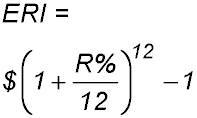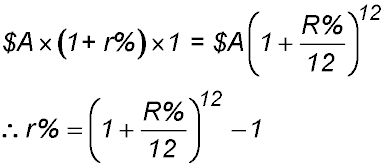Where the techniques of Maths
are explained in simple terms.
Financial Maths - Effective Annual interest rate.
- Algebra & Number
- Calculus
- Financial Maths
- Functions & Quadratics
- Geometry
- Measurement
- Networks & Graphs
- Probability & Statistics
- Trigonometry
- Maths & beyond
- Index
| On this page, the discussion is organised into the following sections: |
| 1. Concept of the rate. |
| 2. Strategy for calculation. |
| 3. When is the rate used? |
A term used to compare different interest rates is the Effective Annual Interest Rate.
It is used frequently in advertisements for buying goods from household products to vehicles.
The term generally describes the rate which equates an investment made with a compounded annual interest rate to an alternative investment over the same time period with simple interest.
The compound rate of annual interest is referred to as the nominal rate of interest because it will be the advertised rate (especially in the case of an investment). The simple interest rate, based on an annual period, is referred to as the effective interest rate. It takes into account the effects of compounding (and any fees charged).
The Effective Rate of Interest (as it is also called) is the basis used to compare advertised rates with differing percentage rates and differing compounding periods. Other names commonly used include effective interest rate, the effective rate or the annual equivalent rate.
Consider investing an amount of $A for one year in two different accounts.
| Invested in a simple interest account or one year: | Invested in an account with interest compounding monthly: | |
| Investment: | $A | $A |
| Interest rate: | r % p.a. (This is the effective rate of interest) |
R % p.a. compounded monthly. (This is the nominal rate of interest). |
| Number of periods in one year: | 1 | 12 |
| Interest calculation: |  |
As the first equation calculates only the interest paid and we want to equate the toal value of the investments at the end of the year,
we add $A to the simple interest amount to give the equation ![]() .
.
We equate these two equations because the values of the two investments are now the same and hence we can determine the value of r%.

As an example, if an investment account was advertised with a nominal interest rate of 5% p.a. compounding monthly:

The final amount at the end of one year of an investment with a nominal monthly compounding interest rate of 5% would therefore be matched by an effective annual interest rate (or a simple interest rate) of 5.12% p.a.
An investment advertised with a nominal rate of 5% p.a. compounding quarterly has an effective annual interest rate of 5.09% -
 .
.
Note that the more frequently interest is paid - and so the larger the number of interest payments made in a year - the higher is the effective interest rate.
The compounding component implies that the nominal rate will always be less than the effective rate.
For an investment, a company always wants to make it appear that it is offering the best possible rate. Hence the effective rate of interest would generally be advertised for an investment rather than the stated annual rate of return - or the nominal rate.
For a loan, a company wants to appear to offer the lowest rate and so will advertise the nominal (or stated annual return) rate with details of the compounding period less prominent.